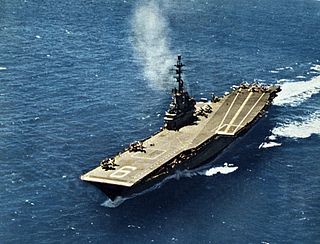Two ships in the United States Navy have been named USS Forrest Sherman for Admiral Forrest Sherman.

The United States Navy (USN) is the naval warfare service branch of the United States Armed Forces and one of the seven uniformed services of the United States. It is the largest and most capable navy in the world and it has been estimated that in terms of tonnage of its active battle fleet alone, it is larger than the next 13 navies combined, which includes 11 U.S. allies or partner nations. with the highest combined battle fleet tonnage and the world's largest aircraft carrier fleet, with eleven in service, and two new carriers under construction. With 319,421 personnel on active duty and 99,616 in the Ready Reserve, the Navy is the third largest of the service branches. It has 282 deployable combat vessels and more than 3,700 operational aircraft as of March 2018, making it the second largest and second most powerful air force in the world.
Admiral is one of the highest ranks in some navies, and in many navies is the highest rank. It is usually abbreviated to "Adm" or "ADM". The rank is generally thought to have originated in Sicily from a conflation of Arabic: أمير البحر, amīr al-baḥr, "commander of the sea", with Latin admirabilis ("admirable") or admiratus ("admired"), although alternative etymologies derive the word directly from Latin, or from the Turkish military and naval rank miralay. The French version – amiral without the additional d – tends to add evidence for the Arab origin.

Forrest Percival Sherman was an admiral in the United States Navy and the youngest person to serve as Chief of Naval Operations until Admiral Elmo Zumwalt in 1970. The Forrest Sherman class destroyer was named for him.
- USS Forrest Sherman (DD-931) was the lead ship of her class and served from 1955 to 1982.
- USS Forrest Sherman (DDG-98) is an Arleigh Burke-class destroyer commissioned January 28, 2006.

USS Forrest Sherman (DD-931) was the lead ship of her class of destroyer of the United States Navy. She was named for Admiral Forrest P. Sherman USN (1896–1951).

The lead ship, name ship, or class leader is the first of a series or class of ships all constructed according to the same general design. The term is applicable to military ships and larger civilian craft.

The 18 Forrest Sherman-class destroyers were the first US post-war destroyers. Commissioned beginning in 1955, these ships served until the late 1980s. Their weaponry underwent considerable modification during their years of service. Four were converted to guided missile destroyers. This class also served as the basis for the Charles F. Adams-class guided missile destroyer.
| This article includes a list of ships with the same or similar names. If an internal link for a specific ship led you here, you may wish to change the link to point directly to the intended ship article, if one exists. |






